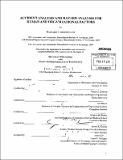| dc.contributor.advisor | Nancy G. Leveson. | en_US |
| dc.contributor.author | Stringfellow, Margaret Virgina | en_US |
| dc.contributor.other | Massachusetts Institute of Technology. Dept. of Aeronautics and Astronautics. | en_US |
| dc.date.accessioned | 2011-06-06T17:42:59Z | |
| dc.date.available | 2011-06-06T17:42:59Z | |
| dc.date.copyright | 2010 | en_US |
| dc.date.issued | 2011 | en_US |
| dc.identifier.uri | http://hdl.handle.net/1721.1/63224 | |
| dc.description | Thesis (Ph. D.)--Massachusetts Institute of Technology, Dept. of Aeronautics and Astronautics, February 2011. | en_US |
| dc.description | "October 2010." Cataloged from PDF version of thesis. | en_US |
| dc.description | Includes bibliographical references (p. 275-283). | en_US |
| dc.description.abstract | Pressures and incentives to operate complex socio-technical aerospace systems in a high-risk state are ever present. Without consideration of the role humans and organizations play in system safety during the development of these systems, accidents will occur. Safe design of the "socio" parts of the sociotechnical system is challenging. Even if the system, including the human and organizational aspects of the system, are designed to be safe for anticipated system needs and operating environments, without consideration of pressures for increased performance and efficiency and shifting system goals, the system will migrate to a high-risk operating regime and safety can be compromised. Accident analysis is conducted to discover the reasons why an accident occurred and to prevent future accidents. Safety professionals have attributed 70-80% of aviation accidents to human error. Investigators have long known that the human and organizational aspects of systems are key contributors to accidents, yet they lack a rigorous approach for analyzing their impacts. Many safety engineers strive for blame-free reports that will foster reflection and learning from the accident, but struggle with methods that require direct technical causality, do not consider systemic factors, and seem to leave individuals looking culpable. An accident analysis method is needed that will guide the work, aid in the analysis of the role of human and organizations in accidents and promote blame-free accounting of accidents that will support learning from the events. Current hazard analysis methods, adapted from traditional accident models, are not able to evaluate the potential for risk migration, or comprehensively identify accident scenarios involving humans and organizations. Thus, system engineers are not able to design systems that prevent loss events related to human error or organizational factors. State of the art methods for human and organization hazard analysis are, at best, elaborate event-based classification schemes for potential errors. Current human and organization hazard analysis methods are not suitable for use as part of the system engineering process. Systems must be analyzed with methods that identify all human and organization related hazards during the design process, so that this information can be used to change the design so that human error and organization errors do not occur. Errors must be more than classified and categorized, errors must be prevented in design. A new type of hazard analysis method that identifies hazardous scenarios involving humans and organizations is needed for both systems in conception and those already in the field. This thesis contains novel new approaches to accident analysis and hazard analysis. Both methods are based on principles found in the Human Factors, Organizational Safety and System Safety literature. It is hoped that the accident analysis method should aid engineers in understanding how human actions and decisions are connected to the accident and aid in the development of blame-free reports that encourage learning from accidents. The goal for the hazard analysis method is that it will be useful in: 1) designing systems to be safe; 2) diagnosing policies or pressures and identifying design flaws that contribute to high-risk operations; 3) identifying designs that are resistant to pressures that increase risk; and 4) allowing system decision-makers to predict how proposed or current policies will affect safety. To assess the accident analysis method, a comparison with state of the art methods is conducted. To demonstrate the feasibility of the method applied to hazard analysis; it is applied to several systems in various domains. | en_US |
| dc.description.statementofresponsibility | by Margaret V. Stringfellow. | en_US |
| dc.format.extent | 283 p. | en_US |
| dc.language.iso | eng | en_US |
| dc.publisher | Massachusetts Institute of Technology | en_US |
| dc.rights | M.I.T. theses are protected by
copyright. They may be viewed from this source for any purpose, but
reproduction or distribution in any format is prohibited without written
permission. See provided URL for inquiries about permission. | en_US |
| dc.rights.uri | http://dspace.mit.edu/handle/1721.1/7582 | en_US |
| dc.subject | Aeronautics and Astronautics. | en_US |
| dc.title | Accident analysis and hazard analysis for human and organizational factors | en_US |
| dc.type | Thesis | en_US |
| dc.description.degree | Ph.D. | en_US |
| dc.contributor.department | Massachusetts Institute of Technology. Department of Aeronautics and Astronautics | |
| dc.identifier.oclc | 722473179 | en_US |
